 W
WAchelousaurus is a genus of centrosaurine ceratopsid dinosaur that lived during the Late Cretaceous Period of what is now North America, about 74.2 million years ago. The first fossils of Achelousaurus were collected in Montana in 1987, by a team led by Jack Horner, with more finds made in 1989. In 1994, Achelousaurus horneri was described and named by Scott D. Sampson; the generic name means "Achelous lizard", in reference to a Greek mythological figure, and the specific name refers to Horner. The genus is known from a few specimens consisting mainly of skull material from individuals, ranging from juveniles to adults.
 W
WAfrovenator is a genus of megalosaurid theropod dinosaur from the middle Jurassic Period of northern Africa.
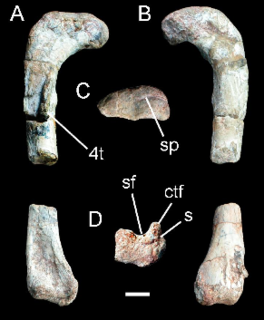 W
WAlwalkeria is a genus of basal saurischian dinosaur from the Late Triassic, living in India. It was a small bipedal omnivore.
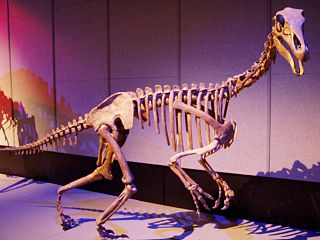 W
WAlxasaurus is a genus of therizinosauroid theropod dinosaurs from the Early Cretaceous Bayin-Gobi Formation of Inner Mongolia. They are some of the earliest known members of the Therizinosauroidea, but they already possessed the body shape—including the long neck, short tail, and relatively large claws—of later therizinosauroids. Like other members of this group, it was a bipedal herbivore with a large gut to process plant material. Several specimens are known and they vary in size.
 W
WAmbulocetus is a genus of early amphibious cetacean from the Early Eocene (Lutetian) Kuldana Formation in Pakistan. It contains one species, A. natans. The genus name comes from Latin ambulare "to walk" and cetus "whale", and the species name natans "swimming". It is known primarily from a single skeleton which is about 80% complete, and is among the most completely known Eocene cetaceans, instrumental in the study of cetacean evolution and the transition from land to sea. Most notably, Ambulocetus had four functional limbs, and was the first cetacean postulated to have preserved a suite of adaptations consistent with an amphibious lifestyle. Ambulocetus is classified in the group Archaeoceti—the ancient forerunners of modern cetaceans whose members span the transition from land to sea—and in the family Ambulocetidae, which includes Himalayacetus and Gandakasia.
 W
WAnochetus ambiguus is an extinct species of ant in the subfamily Ponerinae known from two possibly Miocene fossils found on Hispaniola. A. ambiguus is one of eight species in the ant genus Anochetus to have been described from fossils found in Dominican amber and is one of a number of Anochetus species found in the Greater Antillies.
 W
WAnochetus conisquamis is an extinct species of ant in the subfamily Ponerinae known from one possibly Miocene fossil found on Hispaniola. A. conisquamis is one of eight species in the ant genus Anochetus to have been described from fossils found in Dominican amber and is one of a number of Anochetus species found in the Greater Antilles.
 W
WAnochetus corayi is an extinct species of ant in the subfamily Ponerinae known from one possibly Miocene fossil found on Hispaniola. A. corayi is one of eight species in the ant genus Anochetus to have been described from fossils found in Dominican amber and is one of a number of Anochetus species found in the Greater Antillies.
 W
WAnochetus dubius is an extinct species of ant in the subfamily Ponerinae known from two possibly Miocene fossils found on Hispaniola. A. dubius is one of eight species in the ant genus Anochetus to have been described from fossils found in Dominican amber and is one of a number of Anochetus species found in the Greater Antillies.
 W
WAnochetus exstinctus is an extinct species of ant in the subfamily Ponerinae known from two possibly Miocene fossils found on Hispaniola. A. exstinctus is one of eight species in the ant genus Anochetus to have been described from fossils found in Dominican amber and is one of a number of Anochetus species found in the Greater Antillies.
 W
WAnochetus intermedius is an extinct species of ant in the subfamily Ponerinae known from two possibly Miocene fossils found on Hispaniola. A. intermedius is one of eight species in the ant genus Anochetus to have been described from fossils found in Dominican amber and is one of a number of Anochetus species found in the Greater Antilles.
 W
WAnochetus lucidus is an extinct species of ant in the subfamily Ponerinae known from two possibly Miocene fossils found on Hispaniola. A. lucidus is one of eight species in the ant genus Anochetus to have been described from fossils found in Dominican amber and is one of a number of Anochetus species found in the Greater Antillies.
 W
WAokiichthys is an extinct genus of basal osteoglossoid from an Early Cretaceous freshwater palaeolake of what is now Kyushu, Japan. The genus formed a species radiation in the First Formation within the Wakino Subgroup of the Kwanmon Group, as a dominant member and namesake of the Nipponamia-Aokiichthys fauna. The genus became extinct at the end of either the 1st Formation, or possibly during the 2nd Formation, when the palaeolake became shallower.
 W
WArdipithecus ramidus is a species of australopithecine from the Afar region of Early Pliocene Ethiopia 4.4 million years ago (mya). A. ramidus, unlike modern hominids, has adaptations for both walking on two legs (bipedality) and life in the trees (arboreality). However, it would not have been as efficient at bipedality as humans, nor at arboreality as non-human great apes. Its discovery, along with Miocene apes, has reworked academic understanding of the chimpanzee-human last common ancestor from appearing much like modern day chimpanzees, orangutans and gorillas to being a creature without a modern anatomical cognate.
 W
WAsiatheriidae is an family of Cretaceous metatherians in the order Asiadelphia. Different from the Ameridelphia, they lacked a prominent distolateral process on the scaphoid, and possessed a more slender fibula. The masseteric fossa is deeper in this group than the true marsupials.
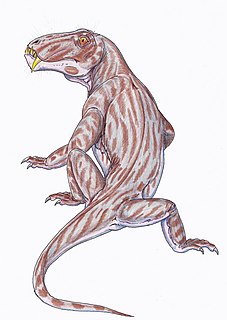 W
WAustralosyodon is an extinct genus of dinocephalian therapsids from the middle Permian of South Africa. The first fossil was discovered in the 1980s near the village of Prince Albert Road in the Karoo region of South Africa.
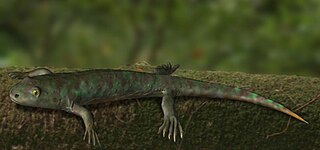 W
WBalanerpeton is an extinct genus of temnospondyl amphibian from the Visean stage of the Early Carboniferous period. It reached approximately 50 cm (20 in) in length. Balanerpeton woodi was discovered by Stanley Wood and is the earliest and most common tetrapod in the East Kirkton Limestone of the East Kirkton Quarry assemblage of terrestrial amphibians in Scotland. Characteristics of Balanerpeton woodi include the presence of large external nares, large interpterygoid vacuities, and an ear with a tympanic membrane and rod-like stapes. Numerous studies and research regarding ontogeny in non extant taxa have been oriented around this taxon. The morphology of the stapes suggests that the animal was capable of hearing high-frequency sound. B. woodi does not possess lateral line sulci or an ossified branchial system. The principal method of respiration was probably buccal rather than costal, indicated by the small straight ribs.
 W
WCaenagnathasia is a small caenagnathid oviraptorosaurian theropod from the Late Cretaceous of Uzbekistan.
 W
WChacaicosaurus is an extinct genus of long-snouted thunnosaur ichthyosaur known from the northwestern Patagonia area of Argentina.
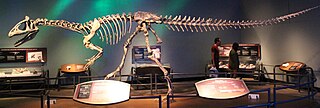 W
WCryolophosaurus is a genus of large theropods known from only a single species Cryolophosaurus ellioti, known from the early Jurassic period of Antarctica. It was about 6.5 metres (21.3 ft) long and 465 kilograms (1,025 lb) in weight, making it one of the largest theropods of its time. Individuals of this species may have grown even larger, because the only known specimen probably represents a sub-adult. Cryolophosaurus is known from a skull, a femur and other material, the skull and femur of which have caused its classification to vary greatly. The femur possesses many primitive characteristics that have classified Cryolophosaurus as a dilophosaurid or a neotheropod outside of Dilophosauridae and Averostra, whereas the skull has many advanced features, leading the genus to be considered a tetanuran, an abelisaurid, a ceratosaur and even an allosaurid. Since its original description, the consensus is that Cryolophosaurus is either a primitive member of the Tetanurae or a close relative of that group, most recently, it has been found to be a derived neotheropod, close to Averostra.
 W
WDlusskyidris is an extinct genus of ant in the Formicidae subfamily Sphecomyrminae, and is one of the five genera placed in the tribe Sphecomyrmini. The genus contains a single described species, Dlusskyidris zherichini, and is known from three Late Cretaceous fossils which have been found in northern Russia.
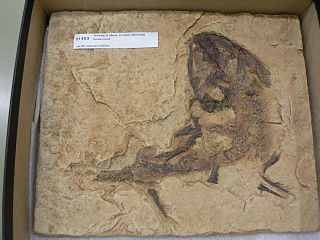 W
WEoscopus is an extinct genus of dissorophoidean euskelian temnospondyl in the family Micropholidae. It is known from Hamilton Quarry, a Late Carboniferous lagerstätte near Hamilton, Kansas.
 W
WEosimias is a genus of early primates, first discovered and identified in 1999 from fossils collected in the Shanghuang fissure-fillings of Liyang, the southern s=city of Jiangsu Province, China. It is a part of the family Eosimiidae, and includes three known species: Eosimias sinensis, Eosimias centennicus, and Eosimias dawsonae. It provides us with a glimpse of a primate skeleton similar to that of the common ancestor of the Haplorhini. The name Eosimias is designed to mean "dawn monkey", from Greek eos "dawn" and Latin simius "monkey".
 W
WEupterodactyloidea is an extinct group of pterodactyloid pterosaurs that existed from the latest Late Jurassic to the latest Late Cretaceous periods. Eupterodactyloids lived on all continents except Antarctica.
 W
WEuromanis is the earliest known pangolin. It lived during the Eocene in Europe. Euromanis fossils found in the Messel Pit in Germany. Unlike modern pangolins, it did not bear scales on it's body.
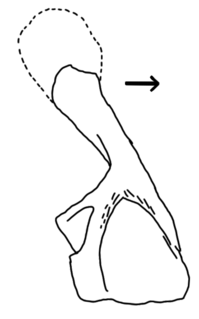 W
WHynerpeton is an extinct genus of early four-limbed vertebrate that lived in the rivers and ponds of Pennsylvania during the Late Devonian period, around 365 to 363 million years ago. The only known species of Hynerpeton is H. bassetti, named after the describer's grandfather, city planner Edward Bassett. Hynerpeton is known for being the first Devonian four-limbed vertebrate discovered in the United States, as well as possibly being one of the first to have lost internal (fish-like) gills.
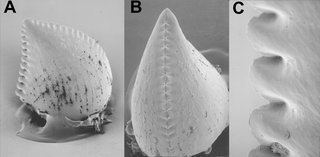 W
WKoparion is a genus of small coelurosaurian theropod dinosaurs, from the late Jurassic Period, of Utah. It contains the single named species Koparion douglassi which is known only from a single isolated tooth.
 W
WLamiaspis longiripa is an extinct pteraspid heterostracan agnathan vertebrate found in marine strata of Early Devonian Nevada.
 W
WMarasuchus is a genus of basal dinosauriform archosaur which is possibly synonymous with Lagosuchus. Both genera lived during the Late Triassic in what is now La Rioja Province, Argentina. Marasuchus contains a single species, Marasuchus lilloensis.
 W
WMymoorapelta is an ankylosaur from the Late Jurassic (Kimmeridgian-Tithonian) Morrison Formation of western Colorado, USA. The taxon is known from portions of a disarticulated skull, parts of three different skeletons and other postcranial remains. It is present in stratigraphic zones 4 and 5 of the Morrison Formation.
 W
WOdontomachus pseudobauri is an extinct species of ant in the subfamily Ponerinae known from one possibly Miocene fossil found on Hispaniola. O. pseudobauri is one of two species in the ant genus Odontomachus to have been described from fossils found in Dominican amber and is one of a number of Odontomachus species found in the Greater Antilles.
 W
WOdontomachus spinifer is an extinct species of ant in the subfamily Ponerinae known from one possibly Miocene fossil found on Hispaniola. O. spinifer is one of two species in the ant genus Odontomachus to have been described from fossils found in Dominican amber and is one of a number of Odontomachus species found in the Greater Antilles.
 W
WOrdosemys is an extinct genus of sea turtle from the Cretaceous period.
 W
WParaponera dieteri is an extinct species of Miocene ant in the genus Paraponera. The fossils of the species were found in the Dominican amber and were described by Baroni Urbani in 1994. The fossils are now in the collection of the State Museum of Natural History Stuttgart.
 W
WPelecanimimus is a genus of basal ("primitive") ornithomimosaurian dinosaur from the Early Cretaceous of Spain. It is notable for possessing more teeth than any other member of the Ornithomimosauria, most of which were toothless.
 W
WPhuwiangosaurus is a genus of titanosauriform dinosaur from the Early Cretaceous (Valanginian-Hauterivian) Sao Khua Formation of Thailand. The type species, P. sirindhornae, was described by Martin, Buffetaut, and Suteethorn in a 1993 press release and was formally named in 1994. The species was named to honor Princess Maha Chakri Sirindhorn of Thailand, who was interested in the geology and palaeontology of Thailand, while the genus was named after the Phu Wiang area, where the fossil was discovered.
 W
WProtopsephurus is an extinct genus of paddlefish which existed in China during the Barremian age to the Aptian age of the Early Cretaceous period. It contains the species Protopsephurus liui, which was measured to be up to be one meter in length.
 W
WRodhocetus is an extinct genus of protocetid early whale known from the Lutetian of Pakistan. The best-known protocetid, Rodhocetus is known from two partial skeletons that taken together give a complete image of an Eocene whale that had short limbs with long hands and feet that were probably webbed and a sacrum that was immobile with four partially fused sacral vertebrae. It is one of several extinct whale genera that possess land mammal characteristics, thus demonstrating the evolutionary transition from land to sea.
 W
WSarmatosuchus is an extinct genus of archosauriform reptile found in sediments of early Triassic age and known from the single species Sarmatosuchus otschevi. Its one of the earliest stem-archosaur species known. The holotype and only specimen was found in lithified river deposits of the Donguz Formation exposed near the Berdyanka River, Orenburg region, Russia. The genus was originally included in the extinct family Proterosuchidae. However, later analysis by David Gower and Andrei Sennikov, the describing author, has removed it from the Proterosuchidae and designated it a basal archosaur.
 W
WSinraptor is a genus of metriacanthosaurid theropod dinosaur from the Late Jurassic. The name Sinraptor comes from the Latin prefix "Sino", meaning Chinese, and "raptor" meaning robber. The specific name dongi honours Dong Zhiming. Despite its name, Sinraptor is not related to dromaeosaurids like Velociraptor. Instead, it was a carnosaur distantly related to Allosaurus. Sinraptor and its close relatives were among the earliest members of the Jurassic carnosaurian radiation. Sinraptor still remains the best-known member of the family Metriacanthosauridae, with some older sources even using the name "Sinraptoridae" for the family.
 W
WSuminia is an extinct genus of basal anomodont that lived during the Tatarian age of the late Permian, spanning approximately from 268-252 Ma. Suminia is recognized as a representation of the youngest of the known anomodonts that are not dicynodonts. Its fossil localities are primarily derived from the Kotel’nich locality of the Kirov region in Russia. However, there have been some isolated specimen found in a few different localities, all from eastern European regions of Russia.
 W
WVentastega is an extinct genus of stem tetrapod that lived during the Upper Fammenian of the Late Devonian, approximately 372.2 to 359 million years ago. Only one species is known that belongs in the genus, Ventastega curonica, which was described in 1996 after fossils were discovered in 1933 and mistakenly associated with a fish called Polyplocodus wenjukovi. ‘Curonica’ in the species name refers to Curonia, the Latin name for Kurzeme, a region in western Latvia. Ventastega curonica was discovered in two localities in Latvia, and was the first stem tetrapod described in Latvia along with being only the 4th Devonian tetrapodomorph known at the time of description. Based on the morphology of both cranial and post-cranial elements discovered, Ventastega is more primitive than other Devonian tetrapodomorphs including Acanthostega and Ichthyostega, and helps further understanding of the fish-tetrapod transition.
 W
WWaipatia is an extinct genus of whale from the late Oligocene (Chattian) of New Zealand.
Windermeria aitkeni is a Precambrian organism from the Blueflower Formation of Sekwi Brook North, in the Northwest Territories of Canada. Only one specimen has been found. Windermeria is a small segmented elongated oval fossil with eight nearly equal-sized segments arranged transverse to medial furrow in opposite arrangement. Windermeria superficially resembles a diminutive Dickinsonia and as such is the only possible dickinsoniid proarticulatan known exclusively from outside of Australia and East Europe.
 W
WYaguarasaurus is an extinct genus of mosasauroid from the Late Cretaceous (Turonian) period of Colombia, South America. The remains discovered were defined as a new genus and species of mosasaurid, Yaguarasaurus columbianus, by the Colombian paleontologist María Páramo, former director of the Museo de Geología José Royo y Gómez of INGEOMINAS in Bogotá. The first fossils remains of this animal suggested a cranial length of 47 centimetres (19 in) and a total length of 5 metres (16 ft); an additional skull that measures 87 centimetres (34 in) long implies a larger size.
 W
WZhejiangopterus is a genus of azhdarchid pterosaur known from one species, which lived in China during the late Cretaceous Period. The genus was named in 1994 by Chinese paleontologists Cai Zhengquan and Wei Feng. The type species is Zhejiangopterus linhaiensis. The genus name refers to Zhejiang Province and a Latinized Greek pteron, "wing". The specific name refers to the city of Linhai.